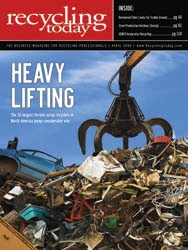The following is a commodity analysis from Oryx Stainless.
The bottoming out of nickel prices on the London Metal Exchange, first seen mid February 2009 was definitely confirmed throughout March and into April. The three months contract was dealt in a very narrow range of between $9,500.00/mt and $10,000.00/mt for over six weeks.
So it is not very surprising that, since the average production costs for nickel of around $15,000.00/mt is well above these rates, more and more primary nickel mining capacities are successively disappearing from the market. Without thinking too much about the future, mines are even being closed which have only just been opened, such as the Ravensthorpe Mine, already closed by BHP Billiton, or the Sinclair Mine in Australia, which is due to be closed in August by Xstrata.
With this though in the background, analysts of a large German bank, which actually has a good knowledge of industrial metals, are predicting a nickel price of $15,000.00/mt by year end.
The present crisis in the steel industry, especially since the last quarter of last year, has been well documented in various press releases. There is a difference, however, between stainless steel and carbon steel, which has consequences on future developments. Whilst stainless steel turnover already began to experience a turn down in the second half of 2007, starting in Asia, leading to a reduction in stocks world wide, the boom phase in carbon steel continued well into the second quarter of 2008.
Only then did a dramatic turn down begin in this sector. Therefore the stainless cycle is more mature than the carbon steel one and the financial crisis “only” added additional pressure to the genuine cyclical behaviour. Low stocks of finished products, along with a reduced availability of scrap, due to (too) low prices, and also the continuing production cut backs in primary commodity supplies, lead to expectations that the nickel price can improve even more, especially as it is seeing its first revival, before in a second stage, the production amounts are also increased. Carbon steel on the other hand must wait a while longer before an improvement can be seen, since the necessary stock depletions have to first take place.
Since the beginning of April, prices have been steadily climbing. With quotations well above $12,500.00/mt a new price level has been reached. Because of the changed, more positive attitude towards further developments, people are wary of selling nickel at this level, making the scenario different from the rally seen in the first few weeks of this year.
Perhaps this change of trend may not just remain as a technical move. An immediate increase in volume in stainless steel production cannot be expected yet though, as the markets are trading at the moment primarily just on expectations.
The demand for stainless steel scrap is relatively high – as measured in the production level – which is especially helped by its cost advantage as opposed to that of primary commodities. Yet the demand, which is based on an extremely limited supply, has not been reflected in the price, and therefore the supply not yet been increased sufficiently.
It is well known that the supply of stainless steel scrap, or rather the availability of stainless steel scrap, is extremely price-elastic. It is very satisfying to note here that in this crisis scenario, it is not the primary commodity producers who are playing first fiddle.
Long term contracts have not been made with the stainless steel industry; the focus is more on facts based on analysis now, irrespective of traditional or emotional viewpoints, which has led to the discovery that scrap, and not only in its price, offers many other advantages. This has led to record quotas in scrap usage of over 70 percent, even with low production amounts, according to first data released. In completely normal production times, the whole commodity needs could not be covered by secondary commodities, due to lack of availability. So something is still left for the primary producers, who can then provide coverage for the rest, different to what has been done in the last few decades. This may not be 100 percent true at the moment, but the trend is definitely heading in this direction.
The replenishing of stocks of nickel in the LME warehouses has come to a (temporary?) halt; in copper there has even been a reduction in the LME warehouse stocks held against warrants. More than 70% of all nickel warrants are in the hands of two market participants. It is assumed that this is not for speculative reasons, but for industrial purposes.
This theory is given more credibility by the fact that the increase in warehouse stocks during the last few months has been a reflection of putting non LME stocks into LME warehouses for liquidity reasons. Warrants from LME certified warehouses, as opposed to using stocks at other warehouses, can be used as security and shown as assets which makes bank financing easier at the moment. By the way, this once again shows how the development of LME stocks can have little bearing on the short term prognosis of prices. That in the present economic environment the LME warehouse stocks would have the tendency to increase is not really surprising. In other words: It could have come from a certain ape quoted in a recent news letter.
Andrew Forrest – well known to many nickel market observers – has made the headlines again. With the company Anaconda Nickel towards the end of the 1990’s he caused turbulence on the nickel market by attempting to develop and exploit, at unprecedented low costs, the nickel mine Murrin Murrin in Australia, using the Pressure Acid Leach process. In the end he only “exploited” the investors. The scheme went drastically wrong. It could even be suggested that with the intention of creating an almost limitless cheap nickel production, the foundation stone was set for the supply shortages later, leading to a nickel rally which finally accumulated in prices of over USD 50,000.00/mt. Investments were no longer made in the more conventional nickel production projects because these were seen to be altogether uneconomical compared to this intended action.
But, unfortunately as per usual, the investment community forgets this quickly, and, after being absent for a few years Mr. Forrest has reappeared on the commodity stage, again in Australia, but this time in the field of iron ore. It is all about participation in the world wide commodity boom. As a mining company, Fortescue Metals Group (FMG), quoted on the stock exchange and where Forrest is a majority share holder, wanted to develop major iron ore resources in Australia and had raised quite large funds for this.
Now, however, the Australian exchange supervisory authority, the Australian Securities and Investment Commission (ASIC) has started legal proceedings against Forrest and his FMG. Damages of 6.6 million and 4.4 million Australian dollars are being sought against FMG and Forrest respectively. The ASIC has accused him of making false claims about the value and accountability of agreements with three Chinese companies.
Basically these claims were about the preparation for the urgently needed development and connection of the mines with the railway network. After the announcement of the development the share price of FMG rose. In retrospect these claims have been proven as incorrect.

Explore the April 2009 Issue
Check out more from this issue and find your next story to read.
Latest from Recycling Today
- Aqua Metals secures $1.5M loan, reports operational strides
- AF&PA urges veto of NY bill
- Aluminum Association includes recycling among 2025 policy priorities
- AISI applauds waterways spending bill
- Lux Research questions hydrogen’s transportation role
- Sonoco selling thermoformed, flexible packaging business to Toppan for $1.8B
- ReMA offers Superfund informational reports
- Hyster-Yale commits to US production





